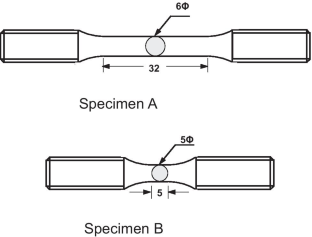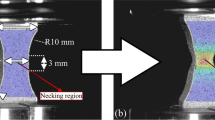Abstract
The prediction of the stress-strain curve at each point in steel HAZ (heat-affected zone) is rather complicated since the HAZ microstructure consists of multiple phases and varies continuously, and hence a simpler prediction method is desired. In this work, thermal simulation tests were conducted for tensile tests and hardness measurements. And using the experimental data, empirical equations to predict the stress-strain curve based on hardness have been developed. The stress-strain curve is divided into three regions. In the first region, the curve is described as a straight line. The curve in the second and the third regions is described by the Swift law, but the constants of the Swift law are different in the second and the third regions. The hardness value is the only data needed for the present prediction. The comparisons of the predictions with the experiments show that the present model can predict the stress-strain curves within an error of 100 MPa for most cases as long as the steel strength is up to 980 MPa. Hence, the present model can provide useful information for the evaluation of weld joint qualities.














Similar content being viewed by others
References
Swift HW (1952) Plastic instability under plane stress. J Mech Phys Solids 1:1–18. https://doi.org/10.1016/0022-5096(52)90002-1
Tomota Y, Umemoto M, Komatsubara N, Hiramatsu A, Nakazima N, Moriya A, Watanabe T, Nanba S, Anan G, Kunishige K, Higo Y, Miyahara M (1992) Prediction of mechanical properties of multi-phase steels based on stress-strain curves. ISIJ Int 32:343–349. https://doi.org/10.2355/isijinternational.32.343
Rauch GC, Leslie WC (1972) The extent and nature of the strength-differential effect in steels. Metall Trans 3:373–385. https://doi.org/10.1007/BF02642041
Fernandes JV, Rodrigues DM, Menezes LF, Vieira MF (1998) A modified Swift law for prestrained materials. Int J Plast 14:537–550. https://doi.org/10.1016/S0749-6419(98)00027-8
Li L, Nagai K, Yin F (2010) Prediction on nominal stress-strain curve of anisotropic polycrystal with texture by FE analysis. Mater Trans 51:1825–1832. https://doi.org/10.2320/matertrans.M2010094
Dimatteo A, Colla V, Lovicu G, Valentini R (2015) Strain hardening behaviour prediction model for automotive high strength multiphase steels. Steel Res Int 86:1574–1582. https://doi.org/10.1002/srin.201400544
Tsuchida N, Harjo S, Ohnuki T, Tomota Y (2014) Stress-strain curves of steels. Tetsu-to-Haganẻ 100:1191–1206. https://doi.org/10.2355/tetsutohagane.100.1191 ((in Japanese))
Hill R (1965) Continuum micro-mechanics of elastoplastic polycrystals. J Mech Phys Solids 13:89–101. https://doi.org/10.1016/0022-5096(65)90023-2
Berveiller M, Zaoui A (1978) An extension of the self-consistent scheme to plastically-flowing polycrystals. J Mech Phys Solids 26:325–344. https://doi.org/10.1016/0022-5096(78)90003-0
Clausen B, Lorentzen T, Leffers T (1998) Self-consistent modelling of the deformation of F. C. C. polycrystals and its implications for diffraction measurements of internal stresses. Acta Mater 46:3087–3098. https://doi.org/10.1016/S1359-6454(98)00014-7
Weng GJ (1985) Micromechanical determination of two-phase plasticity. Int J Plast 1:275–287. https://doi.org/10.1016/0749-6419(85)90008-7
Weng GJ (1990) The overall elastoplastic stress-strain relations of dual-phase metals. J Mech Phys Solids 38:419–441. https://doi.org/10.1016/0022-5096(90)90007-Q
Matsuda K (2002) Prediction of stress-strain curves of elastic-plastic materials based on the Vickers indentation. Philos Mag A 82:1941–1951. https://doi.org/10.1080/01418610208235706
Itakura N, Yasuda K, Aoki M (1998) Properties of HT980 steel plates and welding materials with low cold cracking susceptibility and their applicability to penstocks. Kawasaki Steel Giho 30:174–180 (in Japanese) https://www.jfe-steel.co.jp/archives/ksc_giho/30-3/j30-174-180.pdf
Japanese Industrial Standard JIS G 4051 (2016) Carbon steels for machine structural use, Japanese Standard Association.
Japanese Industrial Standard JIS Z 2241 (2011) Metallic materials -tensile testing- method of test at room temperature, Japanese Standard Association.
Kasuya T, Inomoto M, Okazaki Y, Aihara S, Enoki M (2021) HAZ hardness prediction of boron-added steels. Weld World 65:1609–1621. https://doi.org/10.1007/s40194-021-01111-5
Kunigata M, Aihara S, Kawabata T, Kasuya T, Okazaki Y, Inomoto M (2020) Prediction of charpy impact toughness of steel weld heat-affected zones by combined micromechanics and stochastic fracture model -Part I: Model presentation. Eng Frac Mech 230:106965. https://doi.org/10.1016/j.engfracmech.2020.106965
Kunigata M, Aihara S, Kawabata T, Kasuya T, Okazaki Y, Inomoto M (2020) Prediction of charpy impact toughness of steel weld heat-affected zones by combined micromechanics and stochastic fracture model -Part II: Model validation by experiment. Eng Frac Mech 230:106966. https://doi.org/10.1016/j.engfracmech.2020.106966
Kasuya T, Yokobori AT, Ozeki G, Ohmi T, Enoki M (2021) Modelling of hydrogen diffusion in a weld cold cracking test: Part 1. Experimental determination of apparent diffusion coefficient and boundary condition. ISIJ Int 61:1245–1253. https://doi.org/10.2355/isijinternational.ISIJINT-2020-523
Kasuya T, Yokobori AT, Ozeki G, Ohmi T, Enoki M (2021) Modelling of hydrogen diffusion in a weld cold cracking test: Part 2. Numerical calculations. ISIJ Int 61:1254–1263. https://doi.org/10.2355/isijinternational.ISIJINT-2020-524
Funding
This work was partially supported by Council for Science, Technology and Innovation (CSTI), Cross-ministerial Strategic Innovation Promotion Program (SIP), “Structural Materials for Innovation” (Funding agency: JST), Japan.
Author information
Authors and Affiliations
Corresponding author
Additional information
Publisher’s note
Springer Nature remains neutral with regard to jurisdictional claims in published maps and institutional affiliations.
Recommended for publication by Commission IX - Behaviour of Metals Subjected to Welding
Rights and permissions
About this article
Cite this article
Kasuya, T., Inomoto, M., Okazaki, Y. et al. Stress-strain curve prediction of steel HAZ based on hardness. Weld World 66, 273–285 (2022). https://doi.org/10.1007/s40194-021-01198-w
Received:
Accepted:
Published:
Issue Date:
DOI: https://doi.org/10.1007/s40194-021-01198-w




